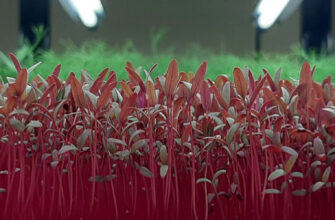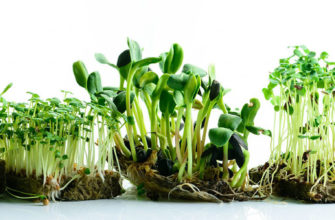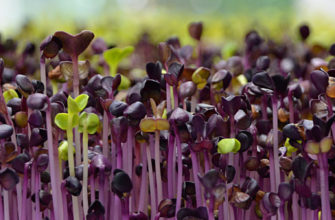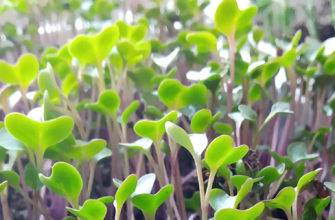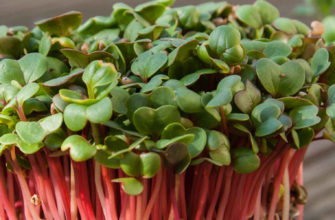Microgreens are one of the most profitable crops you can grow. This makes microgreens an ideal crop for small farms and urban growers. The setup cost is low, and the growing cycle is very fast — meaning you can harvest and sell your first crop in just a couple of weeks. So, how can you make money with microgreens? Read on below.
- Why Growing Microgreens at Home Is a Great Business Idea
- How Much Space Do You Need to Start Growing Microgreens?
- How Much Time Does a Microgreens Business Take?
- What Materials Do You Need to Start Growing Microgreens?
- Microgreens as a Business – Where to Start?
- Step-by-step Business Plan for Growing Microgreens
- Step 1. Finding Clients and Getting to Know Them
- Step 2. Find Quality Information
- Step 3. Testing New Varieties and Growing Methods
- Step 4. Keep Personal Records
- Step 5: Selling Microgreens
- Step 6: Start Simple
- Microgreens as a Business. How to Calculate Costs
- Best Types of Microgreens for Business
Why Growing Microgreens at Home Is a Great Business Idea
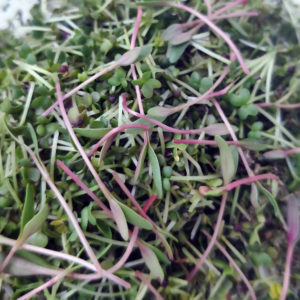
1) Low Startup Costs
You can start your business with just one or two trays of microgreens and scale up gradually. The cost of one tray of ready-to-harvest greens is around 20 UAH (including tray + flax mat + seeds).
At the beginning, you can supply a single restaurant or a local produce store, and then expand your production as demand grows.
2) Fast Turnaround Time
You don’t need to wait an entire season to harvest. Microgreens grow very quickly — from seed to harvest takes just 1 to 4 weeks.
This fast turnaround allows you to experiment and optimize your workflow. It also makes it easy to scale production up or down depending on demand throughout the year.
3) Year-Round Growing
If you don’t have the option to build a greenhouse, microgreens are one of the few crops you can grow all year round — perfect for small-scale farmers.
It’s a great source of steady income. Or, if you’re already a farmer, you can grow microgreens in the off-season to earn extra income and diversify your offerings.
4) Healthy Nutrition
Microgreens are a true superfood — packed with vitamins and nutrients. Their tender greens are loved by chefs in high-end restaurants as garnishes or salad ingredients. Health-conscious consumers also appreciate their nutritional value.
5) High-Value Crop
Microgreens are sold at premium prices in top restaurants and grocery stores. Because they’re a niche product, the profit margins can be very attractive.
How Much Space Do You Need to Start Growing Microgreens?
You don’t need much space at all to start growing microgreens. If you have a spare room or a basement in your home, that’s more than enough to get started.
Most microgreen growers use shelving racks to maximize their vertical space efficiently.
How Much Time Does a Microgreens Business Take?
First of all, it depends on the scale you plan to operate. If you’re growing 10 trays per week, daily maintenance will take no more than 20–30 minutes, plus time for seeding, harvesting, and delivery.
But once you start getting high demand for your greens, it can turn into a full-time job — and you might even need to hire help.
In this way, a microgreens business can take as much time as you’re willing to invest — and earn accordingly. Like in most areas of life, what you get out is directly proportional to what you put in.
However, there are definitely economies of scale you can take advantage of. For example, growing and selling 16 trays won’t take much more time than growing 8 trays — as long as you have buyers for all of them.
What Materials Do You Need to Start Growing Microgreens?
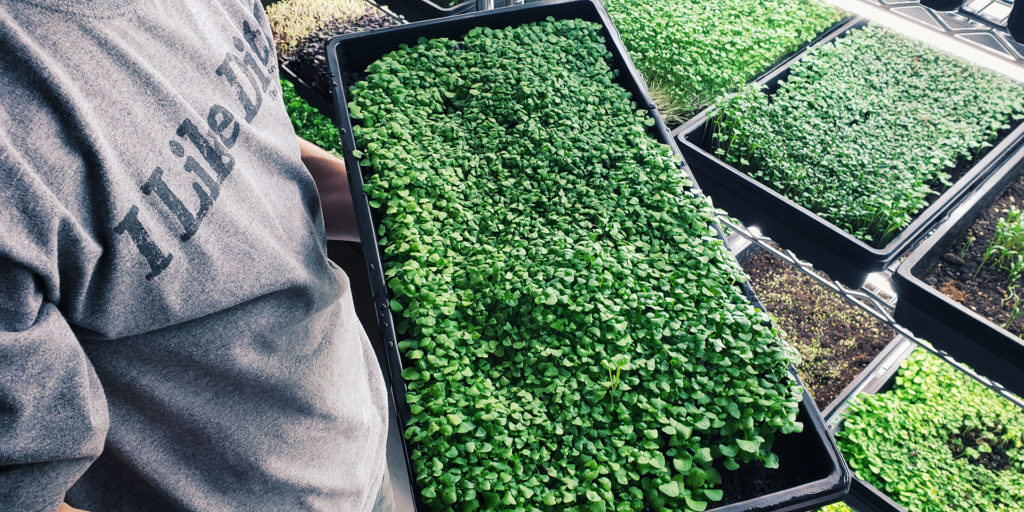
Microgreens farming has a fast return on investment. To launch your microgreens business, you’ll need just a few essential tools and supplies:
- Grow Lights. Fluorescent or LED grow lights can be found in physical or online stores.
- Growing Trays. Some trays can be reused — just make sure to sanitize them between uses.
- Growing Medium (Substrate). Flax mats are ideal: they retain moisture well and keep the greens clean during harvest. Other great options include coconut coir, peat, or even hydroponics. Choose the medium that fits your preferences and budget.
- Water Sprayer. To keep seeds from drying out during germination, water them 2–3 times a day.
- Microgreen Seeds. Start with just a few easy varieties to experiment. Don’t buy too many types right away. Be sure the seeds are not treated with pesticides. Many online stores sell seeds specifically for microgreens. Buying in bulk will save you money in the long run.
- Scale. A basic kitchen scale is perfect for accurately weighing harvested microgreens.
- Scissors or Sharp Knife. A high-quality cutting tool is essential for clean harvesting. Avoid dull blades, as they can damage your crop and slow down the process.
- Timer. To automate your light schedule, use a programmable timer for switching lights on and off.
- Small Fan. Good airflow is crucial. A small fan helps prevent mold and keeps the growing environment healthy.
- Refrigeration. A small cooling chamber or fridge will help keep harvested microgreens fresh until delivery or sale.
Startup costs are relatively low — especially compared to traditional vegetable farming (like cucumbers, tomatoes, or onions).
Microgreens as a Business – Where to Start?
Even if you are successfully growing microgreens, you don’t have a business until you have customers willing to buy them.
That’s why one of the most important things before starting your microgreens business is to do some research and see if your business has a chance of success.
It’s much better to think ahead before investing money and time, only to find out it was all for nothing.
Step-by-step Business Plan for Growing Microgreens
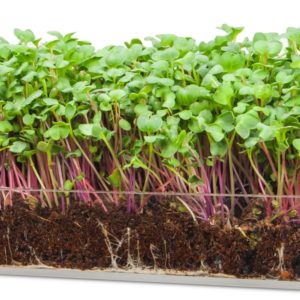
First, think carefully: are you ready to engage in this right now? And do you have enough time to dedicate to this business? If you cannot fully commit yourself to the work, it might be better to postpone this business idea for later.
Next, find out if growing and selling microgreens is profitable in your region and if there is demand for this product. If you are ready and there is demand for microgreens, you can proceed to more decisive actions:
Step 1. Finding Clients and Getting to Know Them
The more you communicate and search for people interested in your microgreens in advance, the less you will need to worry about selling the finished microgreens.
You can use many different sales channels for this. Most farmers involved in large-scale microgreens growing use a combination of several different channels.
Restaurants
To sell microgreens to chefs, prepare an informational price list. This is a sheet containing information about your company, available products, and their prices. Also indicate the cost of microgreens by type, on which days, and in what quantities they are available.
If you arrange regular deliveries with restaurateurs, you will already have a stable buyer. One nuance of cooperating with restaurants is that they may refuse to work with an individual entrepreneur. Therefore, to promote the business in this direction, you may need to register your own sole proprietorship.
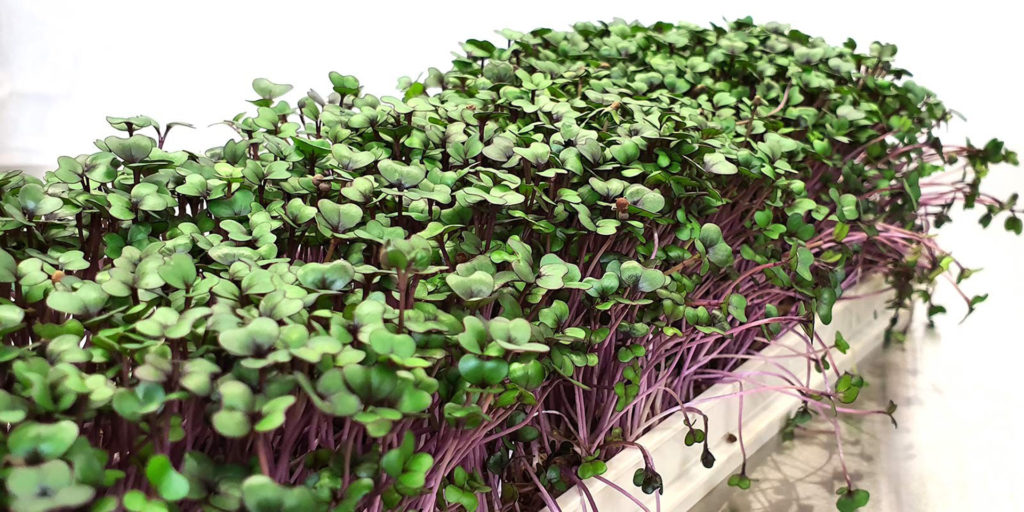
Private Clients
You can deliver microgreens directly to ordinary people who lead a healthy lifestyle. This direction is actively developing now through social networks like Instagram, Facebook, and through groups in various messengers (Telegram, etc.).
You can inspire clients to buy microgreens by providing recipes and various articles about the benefits of this product on a blog or social media page.
Tip: Conduct surveys on your page to understand which new products might interest your clients.
Vegetable Markets
Selling at farmers’ markets can be a quite profitable way to sell microgreens, especially if no one else is selling them at your local market yet.
Grocery Stores
Try to offer cooperation to local grocery stores. Even if they are part of a large chain, they may still be open to new ideas. Especially considering that many customers like to consume local food (locavorism).
Wholesale Market
Selling microgreens wholesale will bring you the lowest amount of money per tray. But in return, a wholesale buyer can purchase a large quantity of microgreens.
Step 2. Find Quality Information
Before you start growing microgreens, you spend a lot of time searching for professional techniques. You read articles on the internet, watch YouTube channels from various producers, buy books, etc.
If you have the financial opportunity, you can look for online courses or webinars on microgreens business training. Yes, these will be additional expenses, but you will save your time because the most important information will be provided by experts. You will also be able to ask your questions to other successful producers who have real experience and reviews in the microgreens business.
Step 3. Testing New Varieties and Growing Methods
At the beginning, every grower spends several weeks or even months on trials. After successes and failures, they find what suits them best.
Try different crops, growing methods, daily light amounts, temperature, seed sowing density, and more. This will help you see what helps and what harms your growing technique.
For information on how to properly grow microgreens, we suggest you read our article: “Methods of Growing Microgreens.”
Step 4. Keep Personal Records
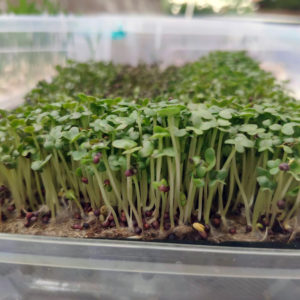
In any business, including a microgreens farm, it is very important to keep good records. There are many nuances to track to find out what works and what doesn’t.
For example, increasing the seed sowing density in a tray might increase the yield. And reducing the light by just 1 hour a day could save electricity costs significantly without negatively affecting the crops.
You can keep notes in a regular notebook. But it’s best to create a spreadsheet in Google Sheets because it has an autosave feature. Plus, you can access it from anywhere and share access with your partners or employees.
Create a separate sheet for each type of microgreens and be sure to record details such as:
- Variety and the name of the company where seeds were purchased;
- Date and time of seed soaking;
- Date and time of sowing;
- Seed sowing density per tray;
- Notes on sowing technique (substrate, seed covering, etc.);
- Growing conditions (lighting, humidity, ventilation, watering);
- Date and time of harvest (including harvesting method and yield size).
It is also important to track business profitability. Calculate the cost price of one tray for each microgreen type and consider whether the product’s price is adequate.
With records, it will be easier for you to understand which microgreens bring the most profit and which are not worth sowing. This will help you focus on what works best.
Additionally, include data in the business plan about other crops you plan to grow. Also think about what else you could sell along with microgreens (for example, DIY microgreen growing kits, recipe books, etc.).
Step 5: Selling Microgreens
You won’t have a microgreens business if you don’t sell it. Otherwise, you are just wasting money and your time.
Actually, growing microgreens is the easiest part of this business. But establishing business relationships to be able to sell your product is quite difficult.
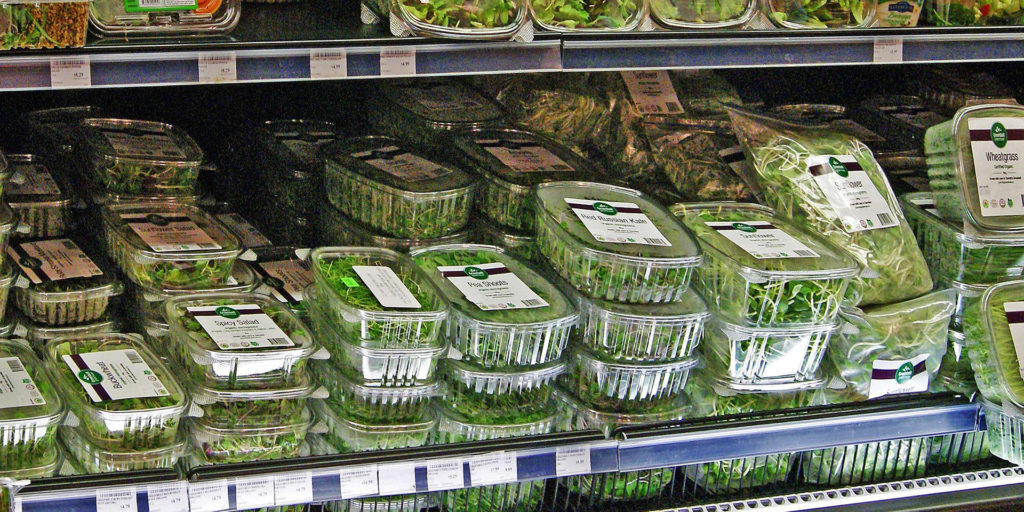
Test which approach to clients works better. For example, try walking into the first restaurant you find and offer your product to the chef. In another restaurant, call the administrator beforehand and arrange a meeting. This way, you will determine which approach is more successful for you.
Also, keep a separate spreadsheet indicating who bought microgreens from you, how much, and which types. Record how they found out about you and how they received their order. Over time, it will become clearer which delivery method is more convenient for your customers.
Step 6: Start Simple
At first, try to keep your microgreens business as simple as possible. Initially, plant one, two, or at most three different types of microgreens. Primarily choose popular crops such as radish, sunflower, peas, etc.
Although lesser-known crops may cost more, it will be harder to find buyers for them. Focus on the main products that will truly bring you reliable income.
Once sales begin, you can start expanding. Also, talk with customers about which other types of microgreens they would like to buy and in what quantities. This way, you can easily adjust to your buyers by growing what will definitely be sold later.
Microgreens as a Business. How to Calculate Costs
To set prices for microgreens, you need to decide how much profit you want to make from this business. If you keep all records in a spreadsheet as mentioned above, calculating the product’s cost price will be easy.
But besides financial expenses, when calculating the cost price, don’t forget your personal contribution. After all, the time you spend caring for the plants could have been spent working elsewhere. So calculate how much you would earn per hour at another job, then how much time you dedicate to producing one tray. This way you will know the full cost.
When selling through different channels, the price of microgreens will vary. For example, selling at a market requires transporting the goods, renting a stall, and spending the whole working day there. Also, some greens may spoil during the day, which adds extra costs.
On the other hand, for example, home delivery of microgreens has no waste and doesn’t require spending the whole day selling the product. But if the customer lives far away, you will need to spend additional fuel and time. The same applies to restaurants.
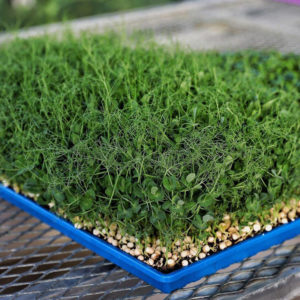
First, you need to monitor the market and check competitors’ prices. This will help you understand the approximate cost price and whether this level of profit suits you.
Start by determining the minimum price you can charge. If there are few competitors selling microgreens in your area, you can raise prices until demand for your product begins to decline. In a very competitive market, you will need to keep prices as low as possible.
If you cannot cover your minimum labor costs, you need to adjust your sales channels. If high competition prevents you from charging what you need for production, then it’s time to increase volumes and diversify your assortment.
It is important to make sure you set prices correctly. Incorrect pricing can lead to negative consequences in the future.
Best Types of Microgreens for Business
As mentioned above, at the start, it’s better not to spread yourself across too many types of microgreens. It’s best to begin with the most popular and easiest to grow varieties. Here are 4 crops that are most suitable for business:
1) Radish
Radish microgreens are very easy to grow. In addition, they have a unique spicy flavor and good color, which chefs really like. This is very delicate greenery that should be sold as soon as possible after harvesting. Otherwise, you can offer customers to buy microgreens together with the substrate. This way, it will stay fresh longer, and clients can cut it themselves.
2) Pea
Pea microgreens yield a good harvest. They look great in exotic dishes by chefs. Also, children love these shoots because their taste resembles young green peas. Another advantage of pea microgreens is that they can be stored in the refrigerator for some time after cutting, which is very important if you cannot sell everything immediately.
3) Sunflower
Most people are familiar with sunflower microgreens, so they hesitate less before buying. Young sunflower shoots have a nutty-sweet taste with a crunchy texture.
For producers, a big plus of sunflower microgreens is that they are quite heavy, so the yield is good. Like pea shoots, sunflower microgreens can be stored in the fridge for a long time.
4) Salad Mixes
Salad mixes are very popular both with restaurant chefs and with those ordering greens for home delivery. This is because these shoots have different tastes, colors, textures, and aromas. They are a great addition to fresh salads and can also be used as a garnish for meat dishes.

To learn about other types of microgreens and their benefits, read our article: “Microgreens: Which Crops to Grow, Their Benefits and Harms.”
Microgreens are a very good business idea. Starting production of this product is easy and fast. This income can be either your main business or an additional source of earnings.
At the beginning of your microgreens business, there will be many trials and errors. You must keep detailed records to find out what works and what doesn’t. The main thing to do at the start is to find a good client base — that’s 90% of success.
If you have found a spelling error, please, notify us by selecting that text and pressing Ctrl+Enter.


